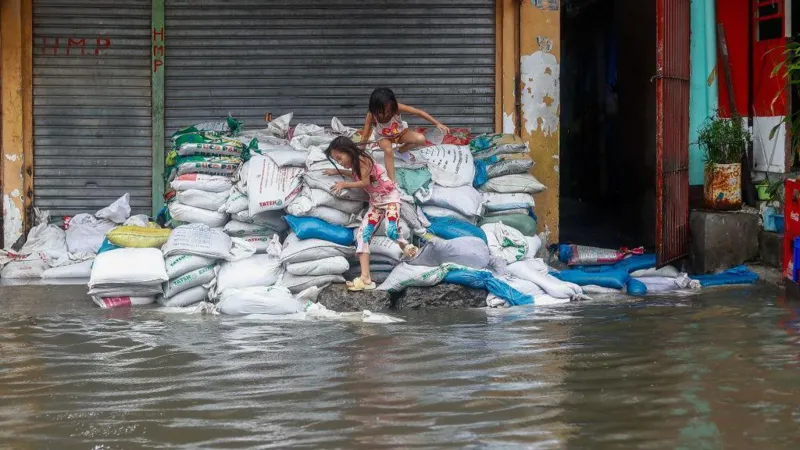Super Typhoon Yagi, one of the worst storms of the year, is speeding towards southern China, set to make landfall on popular tourist destination Hainan later today. The storm, which rapidly intensified after lashing the northern Philippines earlier this week, is now packing winds of 240 km/h (150 mph) near its centre. Meteorologists are bracing for one of the most destructive weather events in recent times, which is expected to have significant impacts across southern China and northern Vietnam.
Super Typhoon Yagi arrives
Super Typhoon Yagi, classified as a Category 5 equivalent storm, has gained strength at breakneck speed. Its current trajectory puts it on track to hit Hainan, a tropical island known for its picturesque beaches and clear waters. In anticipation of the storm’s arrival, local authorities have taken extensive precautions. Trains, boats and flights in the province have been suspended for the second consecutive day, and schools across the wider southern region are closed. These measures underline the seriousness of the threat posed by Yagi.

The arrival of the storm has also led to the closure of all tourist attractions on Hainan Island, as officials warned of the possibility of “heavy and destructive winds”. The situation is further aggravated by the closure of the world’s longest sea bridge, which links Hong Kong to Macau and Zhuhai in Guangdong, highlighting the storm’s widespread impact.
Impacts and predictions
Meteorologists have issued strong warnings about the potential damage Yagi could cause. The Indo-Pacific Tropical Cyclone Warning Center has described Yagi as “extremely dangerous and powerful”, with “potentially catastrophic” consequences predicted if it makes landfall. Heavy rainfall accompanying the storm could reach 500 mm, making an already dire situation even worse.
Hainan, which is accustomed to typhoons, is bracing for a storm of unprecedented strength. Historical data shows that of the 106 typhoons that struck Hainan from 1949 to 2023, only nine were classified as super typhoons. Yagi’s current intensity suggests it will be the most powerful typhoon to hit China’s southern coast in a decade.
Its consequences in the Philippines and the threat it poses to Vietnam
Earlier this week, Yagi devastated northern Philippines, where floods and landslides killed at least 13 people. Thousands of residents had to evacuate their homes as the storm brought torrential rains and strong winds. The devastation in the Philippines underscores Yagi’s severe impact and sets a grim precedent for areas that may be affected.
After its onslaught on Hainan, Yagi is expected to weaken somewhat before making a second landfall in northern Vietnam late Saturday. Vietnamese officials are already preparing for the storm’s arrival, with Deputy Agriculture Minister Nguyen Hoang Hiep warning that Yagi could impact sectors crucial to the country’s socio-economic development. The potential for catastrophic damage in these areas highlights the widespread and severe impact of this storm system.
Climate change and intensifying storms
Yagi’s rapid intensification is a stark reminder of the changing nature of global weather patterns, with climate change playing a key role. Scientists have observed that as ocean temperatures rise, typhoons and hurricanes are becoming more powerful and more frequent. Warmer waters provide more energy for storms, leading to higher wind speeds and more intense rainfall. Additionally, a warmer atmosphere holds more moisture, which contributes to the severity of rainfall during such events.
The increasing frequency and intensity of storms like Yagi is part of a troubling trend that experts attribute to ongoing climate change. As the global climate continues to change, the likelihood of experiencing such catastrophic weather events is expected to increase, presenting a significant challenge for affected regions.
Recent storm activity and future forecast
Yagi’s arrival comes on the heels of Typhoon Shanshan, which affected Japan just a week earlier, resulting in at least six deaths and hundreds of injuries. The recent spate of powerful storms has underscored the growing need for effective disaster preparedness and response strategies in vulnerable regions.
As Yagi approaches, the immediate focus remains on mitigating impacts and ensuring the safety of those in its path. The response to the storm will involve coordinated efforts between local, national, and international agencies to provide aid and support to affected communities.
Conclusion
Super Typhoon Yagi represents a difficult challenge for southern China and northern Vietnam, with the potential for catastrophic damage that highlights the urgent need for effective emergency preparedness and response. Yagi’s impacts will be more pronounced as the storm approaches landfall.